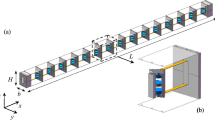Abstract
The working frequency band of an integral electro-optical modulator (EOM) significantly depends on the specific electric conductivity of the material of electrodes. In the case of optimum matching between velocities of the light wave and modulating microwave, the frequency dependence of the EOM response is determined by losses in electrodes related to the skin effect. In this case, the passage from traditional gold to silver (having a higher specific conductivity) provides for a 1.4-fold increase in the EOM bandwidth.
Similar content being viewed by others
References
A. Chen and E. J. Murphy, Broadband Optical Modulators: Science, Technology, and Applications (CRC Press, Boca Raton, 2012).
B. M. Rahman and S. Haxha, J. Lightwave Technol. 20, 1856 (2002).
G. Ghione, M. Goano, G. Madonna, G. Omegna, M. Pirola, S. Bosso, D. Frassati, and A. Perasso, IEEE Trans. Microwave Theory Tech. 47, 2287 (1999).
N. Anwar, S. S. A. Obayya, S. Haxha, C. Themistos, B. M. A. Rahman, and K. T. V. Grattan, J. Lightwave Technol. 20, 826 (2002).
R. Madabhushi, Proceedings of the Optical Fiber Communication Conference (San Jose, California, 1996), Tech. Digest Ser., Vol. 2, ThB3.
J. Kondo, A. Kondo, K. Aoki, M. Imaeda, T. Mori, Y. Mizuno, S. Takatsuji, Y. Kozuka, O. Mitomi, and M. Minakata, J. Ligtwave Technol. 20, 2110 (2002).
M. Schlesinger and M. Paunovic, Modern Electroplating, 5th ed. (Wiley, Hoboken, 2010).
A. M. Fowler, Radio Frequency Performance of Electroplated Finishes, Proc. IREE. Australia 31, 148 (1970).
K. Noguchi, O. Mitomi, and H. Miyazawa, J. Light-wave Technol. 16, 615 (1998).
K. K. Wong, Properties of Lithium Niobate (The Institution of Electrical Engineers, London, 2002).
Author information
Authors and Affiliations
Corresponding author
Additional information
Original Russian Text © V.V. Lebedev, I.V. Il’ichev, P.M. Agruzov, A.V. Shamray, 2014, published in Pis’ma v Zhurnal Tekhnicheskoi Fiziki, 2014, Vol. 40, No. 17, pp. 39–46.
Rights and permissions
About this article
Cite this article
Lebedev, V.V., Il’ichev, I.V., Agruzov, P.M. et al. The influence of the current-carrying electrode material on the characteristics of integral optical microwave modulators. Tech. Phys. Lett. 40, 743–746 (2014). https://doi.org/10.1134/S1063785014090090
Received:
Published:
Issue Date:
DOI: https://doi.org/10.1134/S1063785014090090




